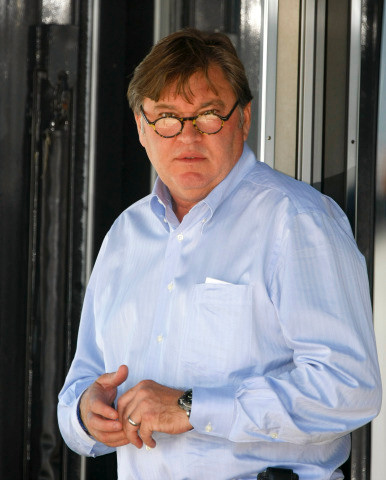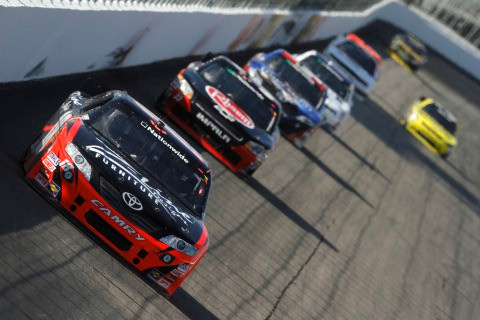The Way It Is/ NASCAR's slow but steady evolution
by Gordon Kirby It's easy to criticize NASCAR but the fact remains that it is by far the big dog of American racing. NASCAR and the NHRA are the two great success stories of American motor sport and NASCAR's reach in the immense number of races it runs plus its at-the-track audience and massive TV time puts it in a class of its own, totalling more than the rest of the diverse world of American racing put together.
It's easy to criticize NASCAR but the fact remains that it is by far the big dog of American racing. NASCAR and the NHRA are the two great success stories of American motor sport and NASCAR's reach in the immense number of races it runs plus its at-the-track audience and massive TV time puts it in a class of its own, totalling more than the rest of the diverse world of American racing put together.
NASCAR also has built a comprehensive ladder system reaching down to the grass roots providing a way forward on a professional path for young drivers, mechanics, engineers and teams as well as building broad and deep fan and media bases.
All this has evolved slowly but steadily over the decades. While other sanctioning bodies have squabbled for control of other forms of the sport, diminishing rather than building the ladder systems that used to exist in open wheel and sports car racing, NASCAR has done the job well and filled the void vacated by others.

© LAT USA
NASCAR has been working for a couple of years on its move to fuel injection and will adopt a McLaren ECU and Bosch injectors as part of its 2012 package. The new system will debut at Daytona next February and become standard ware for the Sprint Cup series. Teams from each of Chevrolet, Ford, Dodge and Toyota tested the fuel injection system at the Kentucky Speedway a few weeks ago. Another test will take place at Phoenix in the fall and everyone will continue dyno testing and working on their new injection systems.
NASCAR's teams have become extremely adept at getting the most out of their carburetors and everyone seems to agree that the engines will make a tiny bit less horsepower with fuel injection. At the same time fuel mileage should improve and no doubt it won't take long for the teams and manufacturers to regain the lost power. At my local Cup weekend in Loudon last week I talked with Robin Pemberton, NASCAR's vice-president of competition, about the move to fuel injection plus 2013's new look and a few other matters.
"It's not that it's complicated," Pemberton remarked about the adoption of fuel injection. "What really takes our process so long is to make sure that when we introduce something like this all the manufacturers and teams have a fair shot of making similar horsepower. This is really the first year that we've had pretty much ninety-eight percent coverage of all the new architecture for the new engines from Ford, Chevy, Dodge and Toyota. We had to get that under our belts before we could go and do the move to fuel injection."
Pemberton commented on NASCAR's choice of McLaren Electronics and Bosch as key component suppliers for the fuel injection system. McLaren supplies 'spec' ECUs to both Formula One and IndyCar of course, while Bosch's record and experience with fuel injection is unparalleled.
"Having McLaren make the ECUs made a lot of sense for us," Pemberton said. "We interviewed a lot of manufacturers, large and small, but nobody else could match their record of success with providing a box to all the other major series and their lack of failure rate and also their reassurance and commitment to us to do what it takes to help us regulate the sport and make sure that nobody can shortcut the system, which is important to us.
"Right now Bosch is the only injector that we'll allow and the O2 sensors will be Bosch. Those are things McLaren had recommended for their system and we don't see any issues with either Bosch or McLaren producing all the necessary stuff to supply everyone. They have strong track records in the industry and we have complete confidence that both of them can do the job.
"So the process is moving along," Pemberton added. "We had the first NASCAR open test for the fuel injection system at Kentucky where every manufacturer had representation. It went well. It's not perfect, but it looked like it was a successful day. Until you're out there laying down lap times among the other competitors you really don't know where you stack up."
NASCAR will permit teams to test fuel injection systems during tire tests over the last half of the year.
"We have opened it up where when teams are doing a Goodyear tire test they can use their fuel injection system during that tire test," Pemberton said. "We'll have a test in early fall at Phoenix for the reconfigured track and we expect we'll have more participation there with the injection system. Testing will continue over the winter into the New Year, then we go full-in at Daytona next February."
Pemberton pointed out that quite a few NASCAR engine builders have solid fuel injection experience with engines built for prototype, sports car, GT and other categories.
"The teams have been running fuel injection for well over a year now at test tracks and a lot of our engine builders and engine companies also build engines for other forms of racing. Between Roush-Yates and the Ilmor/Penske group, or anyone else, they're not short of knowledge or experience with fuel injection."
NASCAR also has been working closely with the manufacturers towards the new look for 2013. New sheet metal will be adopted in the Cup series for 2013 with more brand identifiability like the new Nationwide car.

© LAT USA
"But all the sheet metal will be different. There will be more identity than we've had in any recent history. I don't believe we've had this level of engagement by the manufacturers since I can remember, since maybe going back into the eighties. So that's nice to see.
"We've been dealing with the manufacturers on a regular back and forth basis and they tell us it's good for their own engineering programs and that it's worked around so that their guys in styling are working on this too. As I say, we haven't had that kind of involvement from the manufacturers in quite some time so it feels good. There's a lot of participation from top to bottom by all the manufacturers."
Pemberton stressed NASCAR's approach to doing things thoroughly and methodically rather than rushing into anything new. He emphasized how much ground NASCAR has covered and will cover over a three-year period
"We've taken on a pretty big chunk of apple over a thousand day period," he noted. "Between testing and doing development on the Natonwide car from a year and half or two years ago to the introduction of the new Natonwide car which has proven that it provides good competition. I think that people like what they see there. So when you look at the new Nationwide car, the move to fuel injection and the new 2013 Cup cars, it will have taken a big chunk of our time.
"We've tried to keep all of this in check so that we're not handicapping or hand-cuffing anybody because a lot of changes can sometimes cripple an organization. That's why we're taking our time to do these things right and to make sure that when we do bring something new on-line, everybody has signed up for it and is ready for it. That's all you can hope for as we continue down this path."
The move to McLaren's spec ECU will also enable NASCAR to receive streams of data from every car. Pemberton said NASCAR is taking a careful look at how best to use this data to enhance the fans' knowledge and experience. Of course, the FIA and F1 teams also are currently discussing the same matter.
"The McLaren ECU allows us to work a little bit in some different areas as far as data and what we do with it as far as capturing data," Pemberton said. "Maybe potentially in the near future we can enhance the fan experience with some of this data. We have to figure out how we best get it out of the cars and what we do with it in relation to TV and the internet. All the groups involved in doing the TV and HD cameras are working hard on that right now."
Pemberton said NASCAR also is keeping an eye on the arrival over the next two years of turbo V6 engines in F1 and Indy cars as well as the FIA's interest in encouraging small-capacity turbo four cylinder engines, aka the 'Global Racing Engine'.
"We absolutely are paying attention to and watching how all that progresses," Pemberton remarked. "I think all of us--Formula and IndyCar included--share the same set of problems and that is to try to keep your sport healthy you have to balance what's relevant with competiition. Are you here for competition and for the show? Or are you here for engineering? You have to balance all of that. You can have the coolest thing in the world but if you've only got four race cars running out there it's probably not so cool either.

© LAT USA
"In turn, when we have an appetite for more technology than we ever have, I think we need to look at that. We know there's a lot of momentum toward smaller, more fuel-efficient engines that make good horsepower and you can't do that normally-aspirated. So we'll see how all that turns out. I think everybody is looking at this but it's a hard thing to keep everything in balance.
"At the end of the day, you're looking for what happens between the green and the checkered flag and that's got to be good. You can't hurt yourself by doing things that don't help the show."
Pemberton also is watching the Delta Wing project unfold.
"We've been watching that too," he said. "I'd like to see how that car evolves. I'd like to see one of those cars up close and personally one of these days. If Panoz is going to build them we'll have to go down there to see it."
Before breaking for lunch with Mike Helton and NHMS founder and builder Bob Bahre, Pemberton remarked about how much Tony Stewart and Lewis Hamilton enjoyed their car swap at Watkins Glen last month. He emphasized the point that we're all in this sport together.
"It was good to see how much Hamilton enjoyed driving one of our cars and Tony enjoyed the F1 car," he grinned. "You know, race car guys are race car guys. If you're a drag racer, or a motorcyclist, or doing Formula One or IndyCar, we all like each other's stuff. We like to look at each others' cars and each others' shows and talk about it. We all learn from each other."
Auto Racing ~ Gordon Kirby
Copyright 2011 ~ All Rights Reserved
Copyright 2011 ~ All Rights Reserved
Top of Page